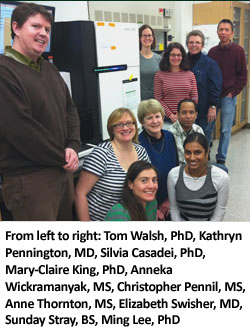


Posted October 31, 2013
Tomas Walsh, Ph.D., and Mary-Claire King, Ph.D., University of Washington
 The discovery of the BRCA1 and BRCA2 genes in the early 1990s had a major impact on clinical care, making it possible for individuals with a family history of breast or ovarian cancer to learn if they carry certain gene mutations that put them at significantly higher risk of developing these cancers. Subsequently, multiple genes in addition to BRCA1 and BRCA2 were also discovered to harbor mutations that significantly increase risk of breast cancer, including PALB2, CHEK2, BARD1, RAD51C, RAD51D, BRIP1, NBN, ATM, TP53, PTEN, STK11, and CDH1. Despite these major discoveries, it is estimated that 70% of families with multiple cases of breast cancer have no mutations in any known gene that predisposes them to the disease. Linkage analyses indicate multiple possible genomic locales for additional breast cancer genes. Dr. Walsh was awarded a Fiscal Year 2008 BCRP Idea Award to identify large genomic mutations in new genes. In collaboration with Dr. King, Dr. Walsh's research team identified and validated 133 rare mutations termed "copy-number variants (CNVs)," of which 7 were found to cause complete deletion or truncation of a gene and co-segregate with breast cancer. These discoveries led to development of a comprehensive test named "BROCA," which enables assessment of all known breast cancer genes and all mutation types in a single assay. Testing of this type is now becoming more widespread in academic and commercial settings, as Drs. Walsh and King freely share design details and bioinformatics scripts.
The discovery of the BRCA1 and BRCA2 genes in the early 1990s had a major impact on clinical care, making it possible for individuals with a family history of breast or ovarian cancer to learn if they carry certain gene mutations that put them at significantly higher risk of developing these cancers. Subsequently, multiple genes in addition to BRCA1 and BRCA2 were also discovered to harbor mutations that significantly increase risk of breast cancer, including PALB2, CHEK2, BARD1, RAD51C, RAD51D, BRIP1, NBN, ATM, TP53, PTEN, STK11, and CDH1. Despite these major discoveries, it is estimated that 70% of families with multiple cases of breast cancer have no mutations in any known gene that predisposes them to the disease. Linkage analyses indicate multiple possible genomic locales for additional breast cancer genes. Dr. Walsh was awarded a Fiscal Year 2008 BCRP Idea Award to identify large genomic mutations in new genes. In collaboration with Dr. King, Dr. Walsh's research team identified and validated 133 rare mutations termed "copy-number variants (CNVs)," of which 7 were found to cause complete deletion or truncation of a gene and co-segregate with breast cancer. These discoveries led to development of a comprehensive test named "BROCA," which enables assessment of all known breast cancer genes and all mutation types in a single assay. Testing of this type is now becoming more widespread in academic and commercial settings, as Drs. Walsh and King freely share design details and bioinformatics scripts.
Recently awarded a Fiscal Year 2012 BCRP Idea Expansion Award, the investigators are now expanding their research to include severely affected families suffering from unidentified mutations. Their hypothesis is that such families harbor individually rare alleles located in regions of the genome that do not directly code for genes. Using a technique called whole genome sequencing, they will evaluate 30 large, extended families severely affected with breast cancer, each of whom were previously evaluated comprehensively for known gene mutations. If successful, this study will lead to identification of regulatory mutations that may reveal new mutational mechanisms for breast cancer predisposition. Moreover, preventive management strategies may be extended to many families for whom the genes causing familial breast cancer are currently unknown.
Publications:
Casadei S, Norquist BM, Walsh T, Stray S, Mandell JB, Lee MK, Stamatoyannopoulos JA, King MC. 2011. Contribution of inherited mutations in the BRCA2-interacting protein PALB2 to familial breast cancer. Cancer Res 71:2222-2229.
Nord AS, Lee M, King MC, Walsh T. 2011. Accurate and exact CNV identification from targeted high-throughput sequence data. BMC Genomics 12:184.
Walsh T, Casadei S, Lee MK, Pennil CC, Nord AS, Thornton AM, Roeb W, Agnew KJ, Stray SM, Wickramanayake A, Norquist B, Pennington KP, Garcia RL, King MC, Swisher EM. 2011. Mutations in 12 genes for inherited ovarian, fallopian tube, and peritoneal carcinoma identified by massively parallel sequencing. Proc Natl Acad Sci USA 108:18032-18037.
Walsh T, Lee MK, Casadei S, Thornton AM, Stray SM, Pennil C, Nord AS, Mandell JB, Swisher EM, King MC. 2010. Detection of inherited mutations for breast and ovarian cancer using genomic capture and massively parallel sequencing. Proc Natl Acad Sci USA 107:12629-12633.
Links:














